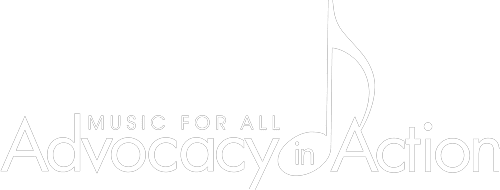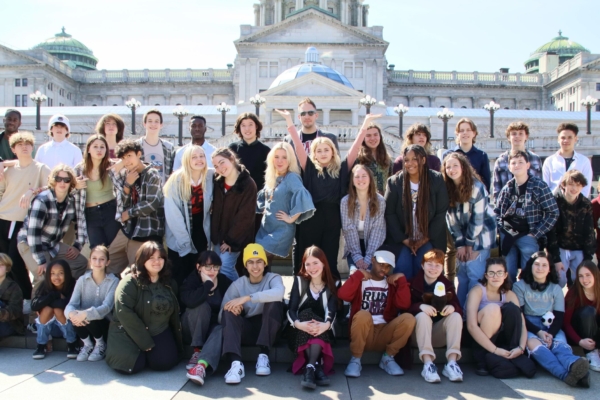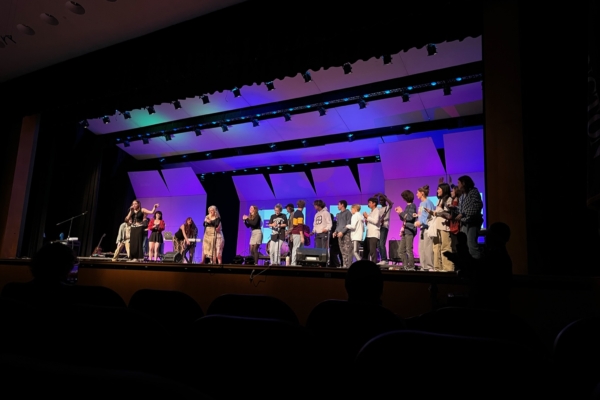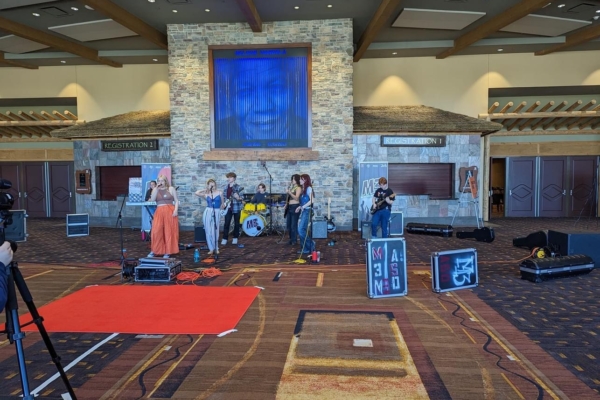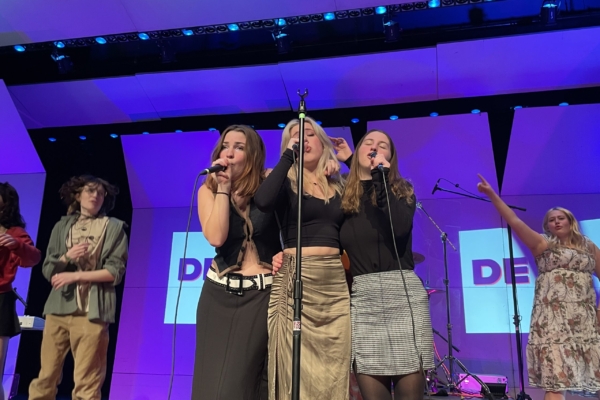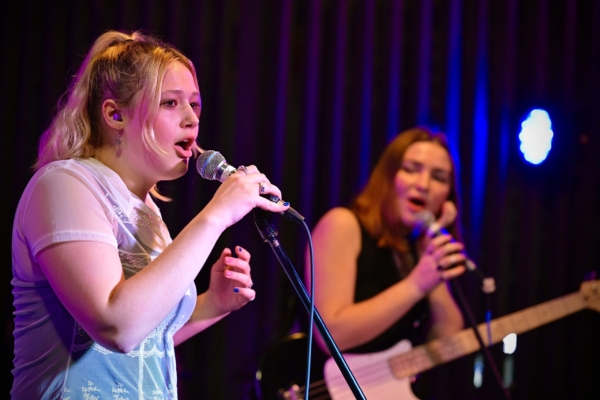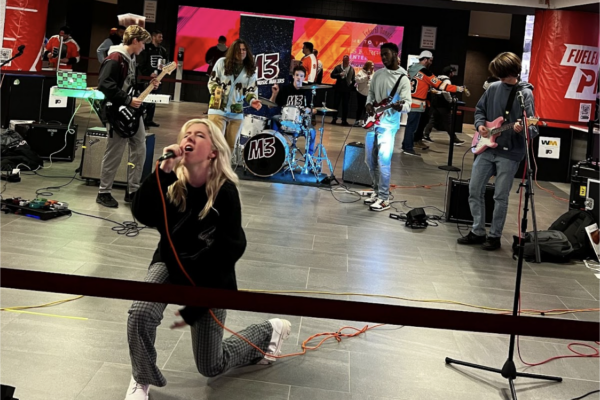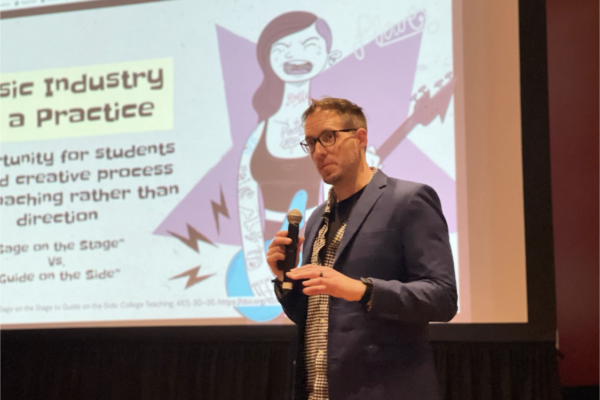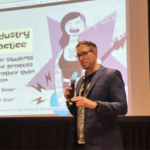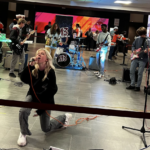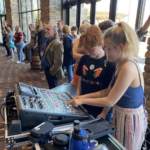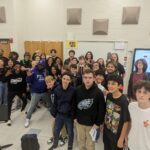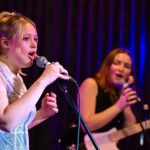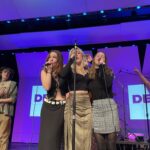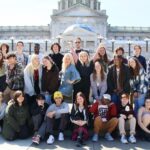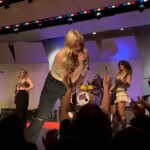“Modern Music Makers (M3)”
Abington School District M3 – Modern Music Makers
Abington, PA
Description
M3 (Modern Music Makers) created music industry programming for students in the Abington School District, designed to create extensive and culturally-responsive opportunities for students. The program desired to encourage and support students to create and produce music which resonated with them, and develop a sense for the music industry as a whole, not just what is traditionally offered in schools. Current programmatic offerings include a student-run record label, several small and large-form performing ensembles, and technical team designed to complete performances and day-to-day operations.
Objectives
When our program began, our students remained in a distance-learning environment. The initial goal was to encourage students to pursue utilizing digital audio workstations as an opportunity to share writing and recording music with each other, best aimed at replicating the experience of making music with friends. As learning paradigms reverted to more traditional, in-person models, the aims of the program evolved to include opportunities for students to write songs together, exploring avenues not currently addressed as greatly within our district’s curricular offerings. In both learning environments, the goal remained to allowed students to make music that they resonated with, and provide a platform for their self expression and individual goals.
As the program continued to progress, we included opportunities for students to create performing groups relative to their own interest, as well as aligning with others with similar interests. Students pursuing singer-songwriter material were able to link up with others whose ideas paralleled, and the same was true with rock music, hip-hop, EDM, etc. As these groups continued to progress, students naturally gravitated towards wanting to record and produce the music they were developing, leading back to the initial goals of the program in music production as a means of collaboration.
These pillars of performance and production allowed us to expand the program in numerous directions, all while maintaining our core values of allowing and encouraging students to make the music that felt most relevant to themselves. Students are able to leverage their agency in learning, which has become another paramount goal of the program: keeping students and their ideas in the driver’s seat. As a result, we’ve been able to tackle incorporating further elements of an expanded music industry application, including artist management, multimedia, performance-based production (live sound and visual design), music distribution, and mentoring of younger students.
Target Audience
The initial target for our focus were the high school students of the Abington School District. Due to a building renovation, these students were required to remain in virtual learning longer than the elementary and middle school students of the district, essentially preventing them from being able to participate in traditional music making practices (ensemble rehearsals, sectionals, performances, etc.). In addition to offering the new possibility of modern music, the program sought to provide them with a framework to continue to make music socially, by whatever means necessary.
In the time since, the program has expanded its focus to include students in Abington Middle School, now spanning grades 6th-12th. In doing so, we’ve provided a similar experience to younger students, with the goal of not only creating new opportunities, but also to increase the number of students willing to participate in music programming in our schools by offering this culturally relevant pedagogy and “breaking the mold” of traditional musical instruction.
As the success of the program became more evident, we strongly considered and eventually executed a commitment to presenting sessions whenever possible for the greater music education community, and in doing so, created further opportunities for our students to not only perform again or a wider audience, but also to share exactly how and why they developed the program in the format that we had.
Timeline
Given that the program was developed during COVID distance learning, there was no immediate timeline presented, aside from the necessary logistical and approval process within our school district. That time frame consisted of a proposal period (approx 2 months), review period with administration (1 month), and execution (1 month).
From there, the project’s evolution consisted of about one (1) total calendar year, during which time our students resumed in person learning, allowing for the program to rapidly evolve to better encompass in-person opportunities as previously described. At the conclusion of this first year, the program had developed the outlines to create the district-wide record label, as well as the form and structure for in-person performance opportunities.
The program is ongoing, and will remain so in perpetuity. The goal of the program remains to provide modern opportunities for music making for our students, regardless of individual or small group interest.
Overview of Planning and Execution
The individuals responsible were Kevin Longwill, Abington School District music teacher and adjunct professor of music education and technology, and Dr. Matthew Harris, Supervisor of Fine Arts for the Abington School District. The concept was originally developed by Mr. Longwill, and a proposal was constructed and provided to Dr. Harris to review and submit to district administration. After an initial review period (1 month), the proposal came to review with other Abington administrators, including Dr. Toni Butz, Director of Teaching and Learning, and Mr. Angelo Berrios, Principal of Abington Senior High School. After the conclusion of discussion and revision, the proposal went to two Abington Senior High School students for submission as a school-based activity. These students, Jason DeMets and Dahlia Ufberg, presented the proposal to the appropriate school committees, who green lit it to move forward.
The program would be remiss if it didn’t include the students and families of M3 as included in the planning and execution of the initiative. While the program remains for the children, it is through their leveraged agency within their own learning that the program has expanded into new and exciting directions, and with the physical and sweat-equity of themselves and their families has developed into the program it is today.
Tools and Resources
As the program first began, we utilized online digital audio workstations (DAWs) and video conferencing software. As learning paradigms shifted to the more traditional, we began to need more traditional equipment and materials, including instruments and sound equipment, as well as continuing to utilize digital audio technology. As our efforts expanded and the program grew, our reliance on these items grew in new ways, incorporating other forms of these technologies, including MIDI guitars, sequencers, and keyboards to pair with DAWs, in-ear monitoring and lighting to pair with our live sound equipment, and an ever expanding instrumental inventory necessary to expand relative to our students’ group and/or individual needs and sounds.
In a slightly different application, we utilized social media and online learning platforms as a means of expanding to a larger audience within our own community as well as those around us, as well as to organize the programs development relative to different groups, schools, and ensembles.
Marketing and Promotion
At first, the program was announced to all students within the high school via in-school announcements. Additionally, notifications were provided to students within the music department, as well as other fine arts students in the school.
After successful implementation, social media platforms, including Instagram, Facebook, and TikTok, were further used to engage the target audience. In doing so, it created further opportunities to engage students in marketing practices, as well as curate an online audience and build a “brand.” For our students interested in eventually pursuing post-secondary studies in marketing or advertising, it made perfect sense to gain practical experience in this space.
With these students at the helm, when our further efforts expanded to include a younger audience, we were better equipped to solicit students to participate in the program, and were very successful in doing so, achieving an initial interest of 150 students in grades 6-8 alone.
Costs
The first expenditures to occur were obtaining instruments and materials in order to be able to equip students for our initial performances. The first series of funding included guitars, keyboards, a sound system, and mixing console totaling $2000.
In the time frame since, there has been considerable expense as the program expanded beyond the initial offering. In order to provide a lab environment for students to create, an approximate cost of $75,000 was provided for computers, workstations, software, and peripherals. As the program’s instrument and recording needs increased, another $12,500 was allotted for instruments, interfaces, microphones, cables, and cases. Word spread regarding the program’s existence, creating new opportunities for performances at conferences to help better advocate for modern music and industry programming, and incurred a cost of $10,000 for performance specific materials, including speakers and monitoring. Further expansion regarding technical development (live sound and lighting) for students created greater costs of approximately $2,000.
Challenges/Obstacles
As referenced previously, the program’s general concept, providing students with opportunity to make music despite being distanced, was solved with a return to in-person learning. As a result, many students were no longer interested in participating in such a program, as traditional social music making opportunities were more readily available. In short, if the program hadn’t been willing to adapt, it would not have survived.
The program chose to pivot, not because of its educator’s goals, but because of the agency of students. The students involved saw the program for what it was, an opportunity to make music they wanted, as opposed to an opportunity to further teach digital literacy. The willingness on the part of the program to allow digital literacy to take a backseat proved all the difference, as students were able to discover that same interest in recording and production after having first developed their own original music, groups, sound, and otherwise. The program was able to come full circle, and in doing so, reinvigorated the student population to continue onward, eventually breaking into new curricular offerings, casting an even wider net of potential students, and creating a greater base of students pursuing music in our schools.
Success/Effectiveness Measurement
When the program first began, we had 25 students participating in the program, taking place once a week for two (2) hours. At the conclusion of the program’s one year anniversary, the program had grown to 60 students in this same format, and at the two-year mark, the high school program featured 100 total students in the extracurricular program, and another 140 in the middle school variation. These numbers reflect a group of students who were able to participate in music making without disrupting their course schedule.
However, the true reflection of the program’s success can only be taken into account when factoring the curricular offerings which grew as a result of the program’s implementation. After 18 months, the school district adapted the program’s structure to build out several new courses, as well as revisions to several standing courses. The district’s music technology offerings, traditionally limited to students in grades 10th-12th, and limited to 20 students per class, were now offered to students as young as 7th grade, with a different course offering available until they graduated high school in 12th grade. Students looking to learn an instrument or study voice for the first time, as many had done while participating in M3’s extracurricular function, were able to do so via instrument and voice lab courses, offered as young as 7th grade. Additionally, students looking to hone their sound and pursue their own interests were able to do so within the context of Modern Music Workshop, a course designed to incorporate elements of music technology along with instrument/voice pedagogy. These courses have proven immensely popular, as the music technology coursework has experienced a 400% growth at the high school level in one year, and sustained enrollment evidenced between 7th-12th grades in each of the other offerings as well.
Community Impact
With many music industry or modern band programs, there appears to be an inherent concern that it will detract from the traditional program offerings of band, chorus, orchestra, and jazz. However, our experience appears to be quite the opposite, as students participating in music industry programs have been more likely to sign up to participate in these more traditional offerings for the first time, or find their way back after a period of absence. Our music industry program has, in effect, helped to strengthen traditional programming in a positive fashion in a post-COVID environment, driving more students through the doors to pursue our traditional ensembles, while simultaneously arming them with new skill sets which can help to drive these programs in a more modern space.
Additionally, the creation and development of a music industry program has helped to encourage more students not interested in traditional music offerings to participate in music making, and in many cases finding they ARE interested in making music, and helping to push them to pursue their own creative endeavors of beat-making, songwriting, production, and/or live performance.
As referenced previously, the program’s aims eventually expanded to include conferences and presentations to the greater music education community. To date, our students have performed and presented at seven different music education conferences at the local, state, national, and international level. We’ve been able to encourage other teachers, schools, and students to develop music industry programs in their own schools. As some of these schools have sprung up at a local level, we’ve aimed to assist in developing new performances to bolster and support where possible, including having guest programs participate in our concerts, as well as the creation of the Modern Music Invitational, a soon-to-be national performance showcase and clinic for music industry and modern band programs.
Advice for others?
A willingness to allow students to help to steer the direction of the program’s development has proven all of the difference in the liveliness of our program. By having the chance to leverage their agency, students help their program to reflect what THEY want to do.
